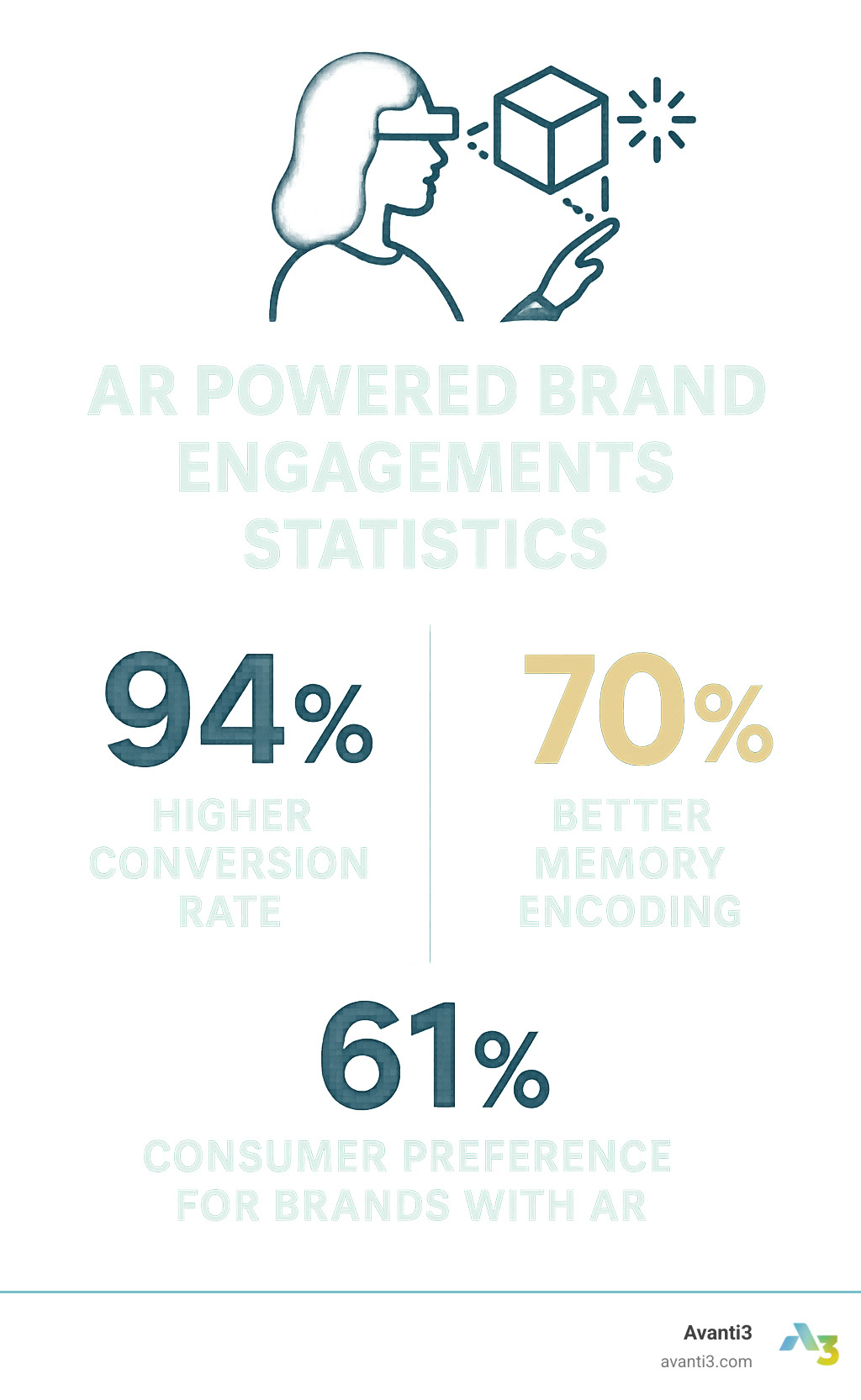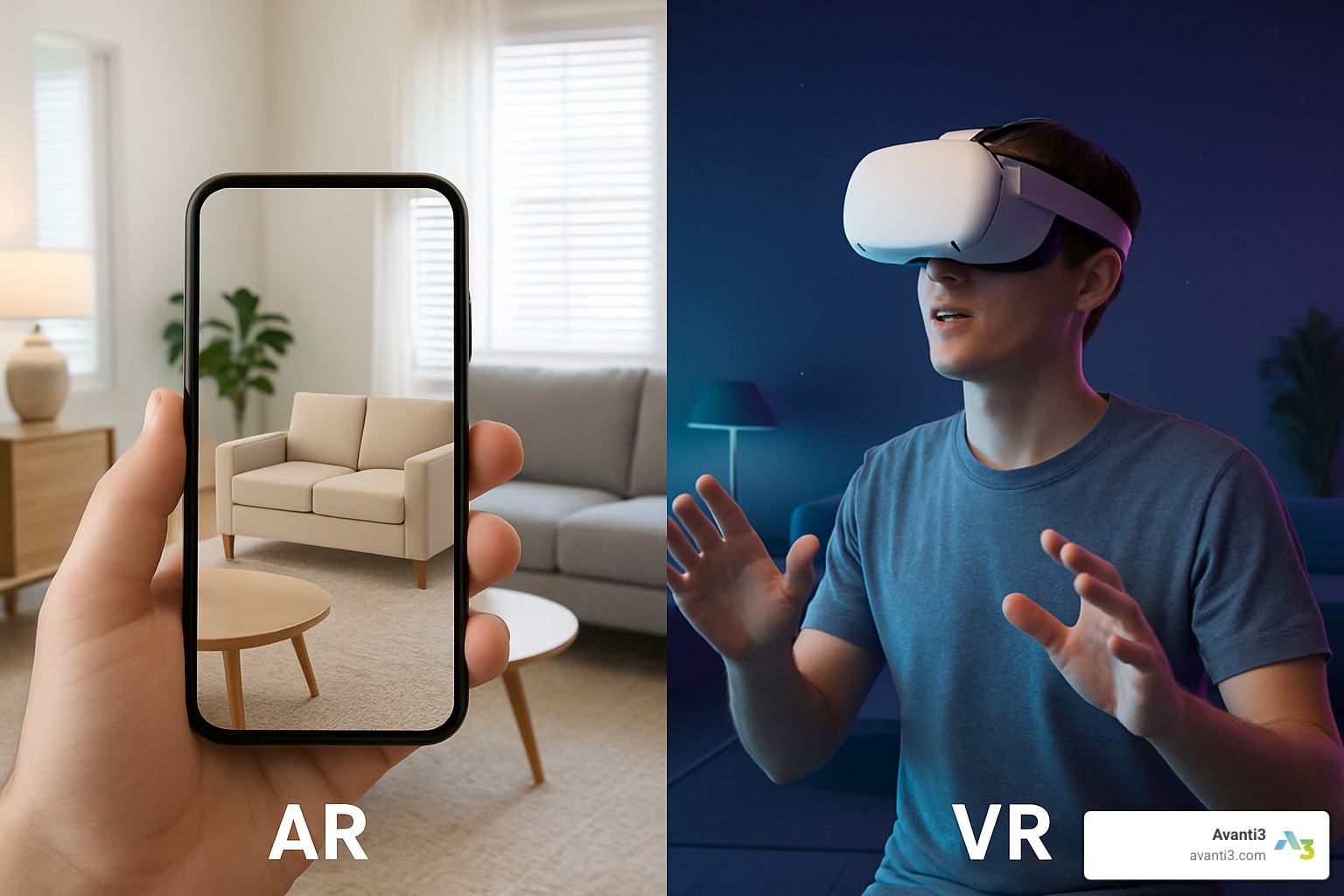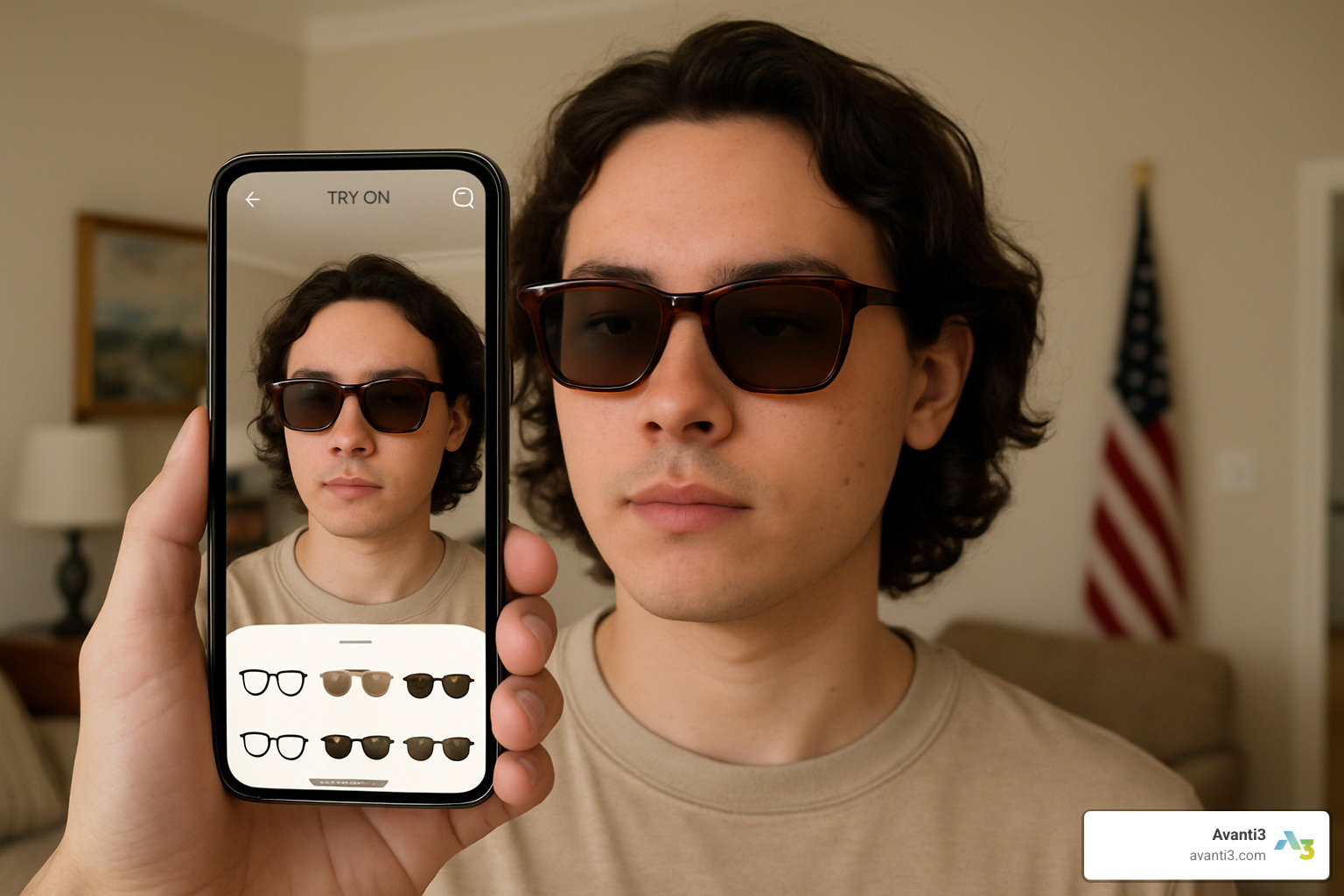AR Powered Brand Engagement: 7 Proven Ways for Stunning Results 2025
The Rise of Immersive Brand Experiences
AR powered brand engagement is the use of augmented reality technology to create interactive, memorable experiences between brands and consumers by overlaying digital content onto the real world. Here’s what you need to know:
- Definition: AR improves real-world environments with digital elements, unlike VR which creates fully immersive virtual worlds
- Key Benefits: 94% higher conversion rates, 70% better memory encoding, and 1.9x higher visual attention compared to traditional marketing
- Popular Applications: Virtual try-ons, 3D product visualization, interactive packaging, social media filters, and in-store AR experiences
- Market Growth: Expected to reach $64.6 billion by 2030, with 75% of the global population becoming frequent AR users by 2025
- Consumer Preference: 61% of consumers prefer brands that offer AR experiences
In today’s competitive marketplace, brands constantly seek innovative ways to cut through the noise and forge meaningful connections with audiences. As consumer attention spans shrink and expectations rise, traditional advertising struggles to make an impact. This is where augmented reality transforms the game.
Unlike passive content consumption, AR creates active participation that captivates users and leaves lasting impressions. When a furniture retailer allows shoppers to visualize a couch in their living room before purchase, or a cosmetics brand enables virtual makeup try-ons, they’re not just showcasing products—they’re creating memorable experiences that drive decisions.
“Memory encoding is 70% higher with AR, and AR drives 1.9x higher visual attention compared to non-AR experiences.”
The power of AR lies in its ability to blend entertainment with utility. It transforms static marketing materials into interactive playgrounds while simultaneously providing valuable information that helps consumers make confident decisions.
I’m Samir ElKamouny AV, an entrepreneur and marketing expert who has helped countless businesses implement AR powered brand engagement strategies that transform customer experiences and drive measurable results. My approach combines innovative AR technology with strategic marketing principles to create experiences that don’t just impress—they convert.

Why This Guide Matters
In today’s attention economy, brands face unprecedented challenges in capturing and maintaining consumer interest. The average person is bombarded with thousands of marketing messages daily, yet their attention span continues to shrink. In this mobile-first world, where smartphones serve as the primary gateway to information and experiences, traditional marketing methods are losing effectiveness.
This guide matters because AR powered brand engagement represents a paradigm shift in how brands connect with audiences. Rather than competing for attention in increasingly crowded channels, AR creates entirely new dimensions for interaction—turning passive viewers into active participants.
Understanding Augmented Reality vs. Virtual Reality
Let’s clear up what makes augmented reality special before we dive deeper into AR powered brand engagement. Think of AR as your reality—just with some digital magic sprinkled on top. Unlike virtual reality, which whisks you away to entirely new worlds, AR improves what’s already around you.
This fundamental difference creates a sweet spot for brands. With AR, you can engage consumers right where they are—in their homes, stores, or anywhere they use their devices—without disconnecting them from their surroundings.

Here’s how these technologies stack up against each other:
| Feature | Augmented Reality (AR) | Virtual Reality (VR) |
|---|---|---|
| Immersion Level | Partial – blends digital and physical | Complete – fully digital environment |
| Real World Visibility | Visible and improved | Completely replaced |
| Hardware Requirements | Smartphones, tablets, AR glasses | VR headsets, controllers |
| User Mobility | High – users can move freely | Limited – physical movement restricted |
| Accessibility | High – works on existing devices | Lower – requires specialized equipment |
| Use Context | Everyday environments | Dedicated VR spaces |
| Brand Integration | Contextual, in-situ experiences | Fully branded virtual environments |
AR sits at a comfortable middle ground on the mixed-reality spectrum. It’s not trying to replace your world—just make it more interesting, informative, and interactive. This is what we call spatial computing—using technology to understand and interact with physical spaces in new ways.
When you use AR, your ordinary surroundings transform through sensory overlay. That empty space on your wall? Now it’s showcasing how that artwork you’re considering would actually look.
Core AR Building Blocks
Behind every delightful AR powered brand engagement experience are several technological wonders working in harmony:
Computer vision is like giving your device a pair of eyes. Through your camera, your phone can actually “see” and understand the world around it—recognizing surfaces, objects, and spaces where digital content can live.
SLAM tracking (which stands for Simultaneous Localization and Mapping) is what keeps that virtual furniture anchored to your floor, even as you walk around the room. Without it, digital objects would float away or jump around as you moved.
Perhaps the most exciting development for brands is WebAR—browser-based experiences that work right from a web link. No app downloads necessary! This removes a huge barrier to engagement, as consumers can instantly interact with your AR content without the commitment of installing something new.
AR Powered Brand Engagement: What, Why & Proof
When we talk about AR powered brand engagement, we’re describing something truly transformative. This isn’t just another marketing tactic—it’s a fundamental shift in how brands and consumers connect. Instead of passively watching ads, people actively participate in experiences that feel personal, memorable, and genuinely helpful.
The numbers behind AR’s effectiveness tell a compelling story. Research shows that our brains encode memories 70% more effectively when information comes through AR experiences compared to traditional content. We pay almost twice as much visual attention to AR content, and perhaps most impressively for businesses, products showcased through AR achieve a 94% higher conversion rate than those without.
Think about what that means in practical terms. When we experience something through AR, it creates a stronger emotional imprint—more joy, more surprise, more connection. This emotional resonance translates directly to action. As scientific research on AR attention impact reveals, after engaging with branded AR experiences, Snapchat users become significantly more likely to make purchases: 2.4x more likely for consumer packaged goods, 2.1x for entertainment products, 1.7x for apparel, and 1.6x for beauty items.

The science here is fascinating. When AR activates multiple senses at once, it creates richer neural pathways and stronger memory formation. By blending digital elements with our physical reality, AR creates a sense of presence that flat media simply can’t match.
Consumer Benefits of AR Powered Brand Engagement
From the shopper’s perspective, AR solves real problems in delightful ways. Personalization stands out as a major benefit—AR experiences adapt to each person’s unique context. Whether you’re virtually trying on different lipstick shades or visualizing how a new dining table would fit in your kitchen, the experience is custom just for you.
This leads to greater product confidence, addressing one of e-commerce’s biggest pain points. When we can see exactly how products will look or fit before buying, we make better decisions. This increased confidence translates directly to reduced returns—one AR shoe-fitting app cut online returns by 28%, saving customers hassle while improving the brand’s sustainability footprint.
There’s also the fun factor. Engaging with novel AR experiences provides valuable social currency—shareable moments that people love to post on social media. These shareable moments extend the experience beyond the individual, creating ripples of engagement.
Brand-Side Advantages of AR Powered Brand Engagement
For businesses, implementing AR powered brand engagement delivers substantial benefits beyond just novelty. When customers can visualize complementary products or premium options, they tend to spend more, leading to higher average order values. One furniture retailer saw a 40% increase in cart value when customers used their AR visualization tool.
AR interactions also generate valuable data insights about consumer preferences. By tracking which products people interact with most, how long they engage with different features, and which experiences lead to conversion, brands gain actionable intelligence for product development and marketing optimization.
Integrating AR Into Your Marketing Mix
Blending AR powered brand engagement into your existing marketing strategy isn’t just about adopting new technology—it’s about creating meaningful moments that connect with your audience in ways traditional media simply can’t. Let’s explore how you can make AR work for your brand.
Think about how your customers interact with your products. Do they need to see how items look on themselves? Or perhaps visualize products in their homes? Understanding these needs helps determine which AR approach will resonate most powerfully.
Virtual try-ons have revolutionized the shopping experience, especially when physical testing isn’t possible. Imagine your customers confidently trying on lipstick shades from L’Oréal without leaving their homes—seeing exactly how colors complement their skin tone before making a purchase.
3D product placement takes the guesswork out of buying larger items. IKEA’s approach lets shoppers place virtual sofas and tables in their actual living rooms, giving them the confidence that pieces will fit both physically and aesthetically. This spatial understanding simply can’t be conveyed through static images.
The playful side of AR emerges in gamified experiences that turn brand interactions into memorable trips. When Tilly’s skatewear created an in-store AR scavenger hunt with a popular YouTube influencer, they weren’t just entertaining customers—they achieved an astonishing 80% voucher redemption rate, their highest ever.
Smart packaging transforms ordinary products into gateways for deeper engagement. The Glenlivet whisky liftd their packaging with AR elements that conjured a holographic host to guide customers through sophisticated tasting notes—turning a simple purchase into an immersive brand education moment.
Want to explore how these solutions might work for your specific needs? Visit Avanti3’s AR Marketing Solutions for more custom guidance.
Step-by-Step Deployment Framework
Turning AR concepts into reality requires thoughtful planning. Here’s how to bring your AR powered brand engagement vision to life:
Start with crystal-clear goal definition. Are you looking to reduce product returns? Drive in-store visits? Create shareable moments that extend your reach? Your specific objectives will guide every decision that follows.
Next, develop your concept and storyboard the entire user journey. Map out each interaction from the moment someone finds your AR experience to the final call-to-action. This visual roadmap helps identify potential friction points before they become problems.
Choosing the right platform is crucial for reaching your audience where they already are. Social media AR through Snapchat or Instagram might be perfect for reaching younger demographics, while WebAR removes download barriers for broader accessibility.
Before full launch, create a minimum viable product and test with a small group. This real-world feedback is invaluable—I’ve seen brands completely rethink their approach after watching actual users interact with their AR experiences. One small usability tweak can often dramatically improve completion rates.
The Future: Trends Shaping Next-Gen Engagement
The world of AR powered brand engagement is evolving at lightning speed. Let’s peek into what’s coming next and how these innovations will transform how brands connect with audiences.
Imagine walking down the street wearing sleek AR glasses that subtly highlight deals at your favorite stores as you pass by. This isn’t science fiction—it’s right around the corner. The future of augmented reality is being shaped by several exciting developments that smart brands are already preparing for.
AI-driven personalization is perhaps the most transformative trend we’re seeing. By combining the immersive power of AR with the intelligence of AI, brands can create experiences that adapt in real-time to each user. Picture an AR furniture app that doesn’t just show you a couch in your living room, but suggests complementary pieces based on your existing décor and past purchases.
AR glasses represent the next big hardware shift. While smartphones have made AR accessible to billions, dedicated wearable devices from tech giants like Apple, Meta, and Google will fundamentally change how we experience augmented content. These hands-free devices will enable AR to become a constant companion rather than something we occasionally access through our phones.

The rollout of 5G networks and edge rendering is quietly revolutionizing what’s possible with AR. These technologies eliminate the frustrating lag that can break immersion, allowing for stunningly detailed and responsive experiences. When AR content appears instantly and moves naturally with your environment, the technology fades into the background and the experience takes center stage.
As we inch closer to the metaverse commerce reality, AR serves as the perfect bridge between physical and digital worlds. Forward-thinking brands are already creating experiences that seamlessly connect in-store shopping with virtual spaces.
Perhaps most importantly, the future of AR will emphasize inclusivity and accessibility. Voice commands, gesture recognition, and thoughtfully designed interfaces will ensure these powerful experiences are available to everyone, regardless of ability. This isn’t just the right thing to do—it’s smart business that expands your potential audience.
According to Gartner’s predictions, 30% of organizations will have metaverse-ready products and services by 2026, with AR serving as a gateway technology. The brands experimenting today will have a significant advantage tomorrow.
Preparing for Always-On AR Experiences
The most forward-thinking brands are already preparing for a world where AR isn’t a special event but an expected part of everyday customer interactions. This shift requires a different strategic approach.
Real-time context will become the secret sauce of effective AR experiences. When your AR content responds intelligently to a user’s location, the time of day, weather conditions, or even their social environment, it creates moments that feel almost magically relevant.
Frequently Asked Questions about AR Powered Brand Engagement
How does AR influence purchase decisions?
Have you ever hesitated to buy something online because you weren’t sure how it would look in real life? This is exactly where AR powered brand engagement works its magic.
AR transforms the way we make buying decisions by removing that nagging uncertainty. When a customer can virtually place a sofa in their living room or try on a pair of glasses without leaving home, that “will it work for me?” barrier simply melts away. It’s like having a risk-free trial before committing to purchase.
Beyond just visualization, AR creates an emotional connection that traditional marketing can’t match. There’s something genuinely delightful about seeing a product come to life in your own space. This emotional response builds stronger brand affinity that influences buying behavior long after the AR experience ends.
AR also delivers product information in a much more intuitive way. Rather than reading through specs or squinting at product dimensions, customers can interact with virtual products to understand features in context. This hands-on learning makes complex products easier to understand and appreciate.
The numbers back this up beautifully. After engaging with branded AR experiences, consumers become up to 2.4x more likely to purchase products. This effect is particularly powerful for visually-driven purchases like furniture, clothing, and beauty products.
Which industries gain the fastest ROI from AR?
While AR powered brand engagement offers benefits across virtually every sector, some industries see their investment pay off almost immediately.
Retail and e-commerce businesses often see the quickest returns, especially when selling products where visualization matters most. Beauty brands offering virtual makeup try-ons report conversion increases within weeks of implementation. Furniture retailers using AR placement tools see cart abandonment rates drop dramatically as customer confidence rises.
Real estate professionals have finded that AR property visualization shortens sales cycles significantly. When potential buyers can visualize different furniture arrangements or renovation possibilities before making a decision, they move through the purchase journey with greater confidence and speed.
The automotive industry has acceptd AR to transform the car-buying experience. Allowing customers to visualize different vehicle colors and features in their own driveway has proven to accelerate consideration and decision-making phases of the typically lengthy car-buying process.
Conclusion & Next Steps
As we’ve journeyed through this guide, it’s become clear that AR powered brand engagement isn’t just a flashy tech trend—it’s changing how brands connect with audiences in meaningful ways. With projections showing 75% of people worldwide becoming regular AR users by 2025, the question isn’t if your brand should accept AR, but how quickly you can integrate it effectively.
The evidence speaks volumes: AR creates experiences that stick in customers’ minds, forge emotional connections, and significantly boost conversion rates. This powerful combination of delight and utility explains why forward-thinking brands are making AR central to their engagement strategies.
If you’re ready to bring AR into your marketing mix, I recommend building an innovation roadmap that starts with your specific business goals. Begin by clearly defining what success looks like for your brand—whether that’s increasing product confidence, driving store visits, or creating shareable moments that extend your reach.
From there, identify which AR applications make the most sense for your audience and products. A furniture retailer might focus on 3D product placement, while a cosmetics brand might prioritize virtual try-ons. The key is matching the technology to genuine customer needs rather than chasing novelty.
I’ve found that starting with small, focused experiments allows brands to gather valuable insights before making larger investments. This approach lets you test concepts, refine the user experience, and build internal expertise without unnecessary risk.
Whatever path you choose, measuring results rigorously is essential. Establish clear benchmarks before launch and track both engagement metrics and business outcomes to demonstrate real impact.
A holistic strategy yields the greatest returns. Rather than treating AR as an isolated campaign element, look for ways to integrate it seamlessly into your broader customer journey. When AR experiences connect naturally with your website, social media, packaging, and in-store environments, they become more findable and valuable.
At Avanti3, we specialize in creating integrated solutions that combine AR/VR with complementary technologies like NFTs, blockchain, and AI. Our approach ensures your customers enjoy consistent, friction-free experiences while your team benefits from streamlined implementation and management.
The future of brand engagement is undeniably immersive, interactive, and intelligent. By embracing AR powered brand engagement today, you’re not just adopting a new marketing tactic—you’re preparing your brand for a world where digital and physical experiences increasingly blend together.
To explore how our AR/VR immersive experiences can transform your brand engagement strategy, visit Avanti3’s AR/VR Immersive Experiences.







